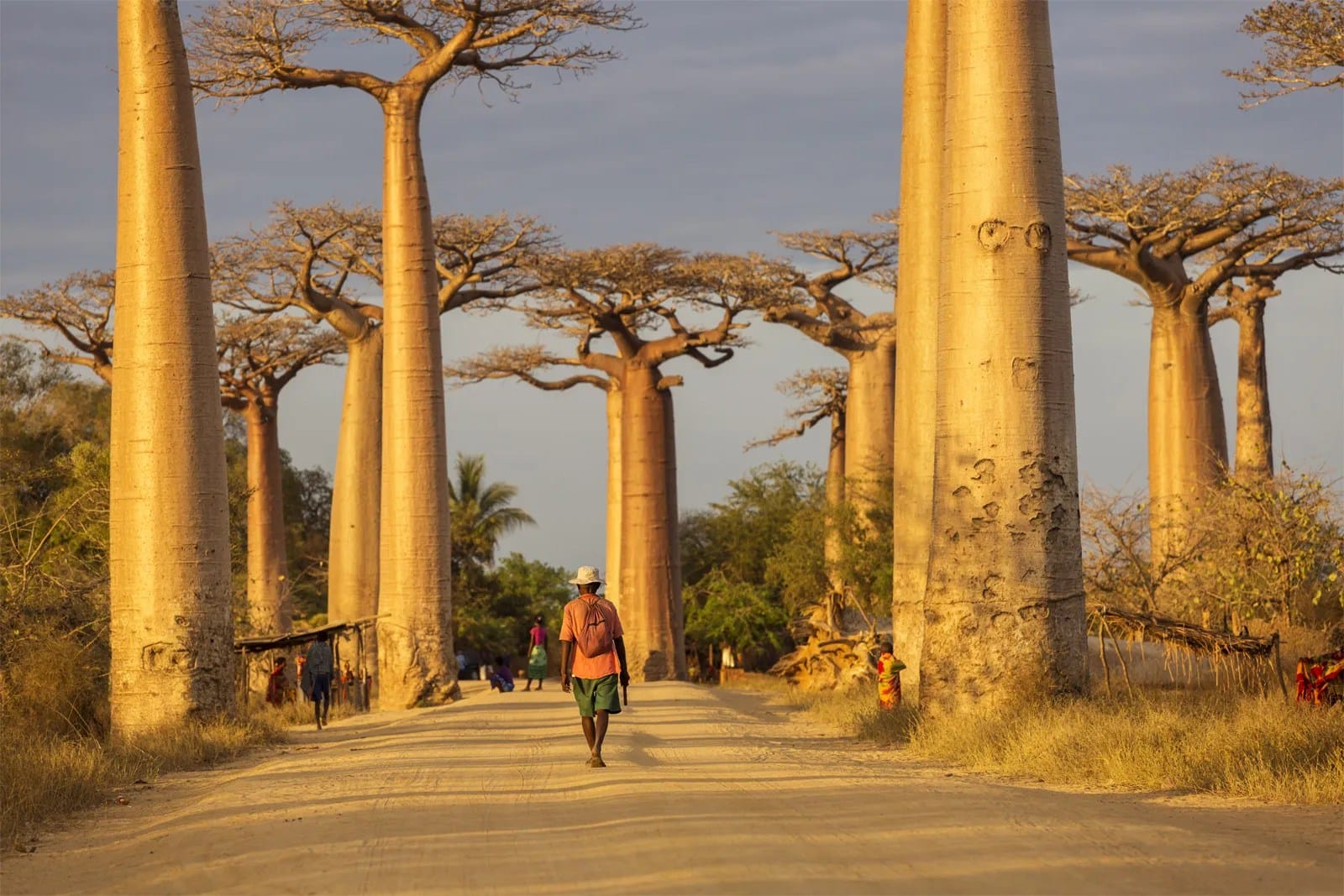A Walk Among Ancient Giants
Picture this: you’re strolling down a dusty road in western Madagascar, bathed in the warm glow of the setting sun. Towering above you are the majestic Grandidier’s baobabs, their massive silhouettes reaching towards the sky like ancient sentinels. This is the Avenue of the Baobabs, a truly unforgettable spectacle and a testament to the enduring power of nature. These ancient trees, some over 800 years old, have silently witnessed centuries of history unfold in the Menabe region.
More Than Just a Picture-Perfect Postcard
The Avenue of the Baobabs is undeniably a photographer’s dream, but its significance goes far beyond its visual appeal. It’s a biodiversity hotspot, representing Madagascar’s unique flora, home to six of the world’s eight baobab species, with the Adansonia grandidieri being endemic to the island. The avenue itself, stretching approximately 260 meters (850 feet), contains 20-25 baobabs lining the road with roughly 25 more scattered across nearby rice paddies and meadows within a 4-hectare (9.9-acre) area. This relatively small area holds immense ecological and cultural value. The baobabs play a vital role in the local ecosystem, providing habitat and resources for various species. Their presence is also deeply intertwined with the cultural heritage of the Menabe region, symbolizing resilience, longevity, and a harmonious relationship with nature. Local folklore and traditions likely weave tales around these majestic giants, adding a layer of mystique to their already impressive presence.
A Delicate Balance: Conservation Efforts
Sadly, these majestic trees face modern-day challenges. Deforestation for farming, water runoff from nearby rice fields, and the ever-present threat of wildfires all endanger the Avenue of the Baobabs. While it was designated a natural monument in July 2015, its protection requires ongoing efforts. Current research suggests that climate change may pose a significant threat to baobabs in the future, making continued conservation work even more crucial. Several organizations are working tirelessly to protect these trees and the surrounding ecosystem. As visitors, we can contribute by supporting local guides, choosing responsible tour operators, and donating to reputable conservation organizations.
Planning Your Journey to the Avenue
Reaching this remote location is an adventure in itself. Most travelers fly into Morondava, a coastal city in western Madagascar. From there, hiring a 4×4 vehicle or joining an organized tour is the most common way to reach the avenue, especially during the rainy season. The dry season, from April to November, offers the best road conditions and stunning lighting for photography. Sunrise and sunset paint the sky and the baobabs in breathtaking colors, making these times particularly magical for a visit.
| Transportation Option | Pros | Cons |
|---|---|---|
| 4×4 Vehicle | Freedom to explore at your own pace, possibility of venturing off the beaten track if conditions permit | Can be more expensive, may require hiring a driver |
| Organized Tour | Hassle-free, often includes other points of interest, local guides provide valuable insights | Less flexibility, fixed itinerary may not suit all travelers |
| Local Taxi (Bush Taxi) | Most budget-friendly option, a chance to immerse yourself in local transportation | Can be crowded and less comfortable, schedules can be unpredictable |
Beyond the Avenue: Exploring the Menabe Region
While the avenue is the main attraction, the surrounding Menabe region offers a wealth of experiences. Explore the unique flora and fauna of the nearby Kirindy Mitea National Park, or discover the heartwarming legend of the Baobab Amoureux – two intertwined baobabs symbolizing everlasting love. Engage with local communities and learn about their deep connection with these incredible trees. Venturing beyond the main road reveals a deeper understanding of Madagascar’s rich culture and stunning natural beauty. Perhaps even consider a leisurely pirogue trip down the Tsiribihina River to the fishing village of Betania for a truly immersive cultural experience. Remember, your visit can contribute directly to the local economy, supporting the communities that call this area home.
Why is the Avenue of the Baobabs Famous?
The Avenue of the Baobabs is more than just a collection of trees; it’s a living testament to time, nature’s resilience, and the rich tapestry of human history. These aren’t just any trees; they are primarily Grandidier’s baobabs (Adansonia grandidieri), some of which have stood tall for an estimated 2,800 years. They were here when the Roman Empire was in its infancy, silently witnessing the rise and fall of civilizations. This remarkable longevity is a key reason for the avenue’s fame, serving as a tangible link to the distant past. The avenue’s formation is thought to be a blend of natural occurrence and human influence. While some baobabs likely sprouted naturally, the clearing of the surrounding dense tropical forests for agriculture probably contributed to the avenue’s distinctive appearance over centuries, leaving these magnificent giants standing in stark relief against the open landscape.
The avenue isn’t merely a visual spectacle; it is a crucial biodiversity hotspot in western Madagascar, supporting a vibrant ecosystem teeming with life. These gentle giants provide shelter and sustenance for a multitude of creatures, from birds and insects to lemurs, playing a vital role in the delicate balance of the surrounding environment. Sadly, this balance is under threat. Deforestation and agricultural expansion pose ongoing challenges to the preservation of these magnificent trees.
Deeply interwoven with the cultural fabric of the region, these trees hold a special place in the hearts of the local communities. They are storytellers, silent witnesses to the passage of time, their gnarled bark whispering tales of a rich and complex history. Each baobab represents a connection to their ancestors and the land, embodying the enduring spirit of Madagascar.
| Feature | Details |
|---|---|
| Location | Western Madagascar, along Route 8, between Morondava and Belon’i Tsiribihina |
| Primary Species | Grandidier’s Baobab (Adansonia grandidieri) |
| Age of Trees | Up to 2,800 years |
| Significance | Cultural, Ecological, Tourist Attraction |
| Conservation | Protected as a natural monument since July 2015 |
Located on the unpaved Route 8, the journey to the avenue itself is an adventure. It’s a road less traveled, where towering baobabs act as nature’s own streetlights, creating a surreal and unforgettable experience. By visiting, you directly contribute to the local economy, providing valuable income for the communities. However, it’s crucial to practice sustainable and responsible tourism to ensure the avenue’s preservation for future generations.
The Avenue of the Baobabs isn’t just famous for its beauty; it’s a confluence of natural wonder, cultural heritage, and ecological significance. It’s a place where the past meets the present, where the choices we make today determine the fate of these ancient giants. Delve into the captivating life of Annia Aurelia Galeria Lucilla and uncover a similar story of legacy and the passage of time. Ongoing research continues to unveil new insights into the baobabs and their ecosystem, reminding us that there is always more to learn about these magnificent trees.
How Much Does It Cost to Visit the Avenue of the Baobabs?
The Avenue of the Baobabs itself is free to visit, like a natural museum open to all. However, getting there and other related expenses will make up your travel budget.
Getting There: Transportation Costs
The most common starting point is Morondava. From there, a roundtrip taxi ride to the avenue typically costs $15-$20. Negotiating fares is a common practice in Madagascar. For greater flexibility, consider renting a car, particularly if you want to visit at different times of day or explore other attractions. Rental costs vary based on the vehicle and rental company. Remember, Route 8 is unpaved, so choose a suitable vehicle.
Additional Expenses: Guides, Refreshments, and Souvenirs
While entry is free, other costs may arise. A local guide can enrich your experience by sharing insights and stories. Check current rates locally. The visitor center near the avenue sells drinks and souvenirs, but prices might be higher than in Morondava. Packing your own snacks and water is a budget-friendly option.
Exploring Beyond the Avenue: Nearby Attractions
The Menabe region offers many captivating sights. The “Baobabs in Love,” two intertwined trees, and the Kirindy Forest Reserve, teeming with unique wildlife, are well worth a visit. A leisurely pirogue trip down the Tsiribihina River to the Betania fishing village provides a glimpse into local culture. Each attraction has its associated costs, so factor them into your budget.
Preserving the Giants: Conservation and Your Contribution
By supporting local businesses and engaging in responsible tourism, you contribute to protecting the baobabs and the ecosystem. Every action counts, from choosing reusable water bottles to respecting the environment.
Budgeting for Your Baobab Adventure
The overall cost of your visit depends on your transportation choices, whether you hire a guide, and if you choose to explore other attractions. Research average prices for accommodation, meals, and activities in the region to plan effectively. Having a buffer in your budget for unexpected expenses is always wise. With careful planning, you can experience the magic of the Avenue of the Baobabs without overspending.
Is Baobab Avenue Worth It?
Absolutely! The Avenue of the Baobabs is more than just a photo opportunity; it’s a powerful experience connecting you with nature’s grandeur and centuries of history. These majestic Adansonia grandidieri, some nearly 800 years old, stand as silent witnesses to the passage of time, offering a humbling and awe-inspiring perspective. Explore the ancient landscapes of the Central Pangean Mountains for another glimpse into the Earth’s remarkable history.
These colossal trees are also botanical marvels. Their massive trunks, sometimes exceeding 30 feet in diameter, store significant amounts of water, enabling them to thrive in the arid climate. Their smooth, reddish-brown bark is a unique texture, and their branches, even when leafless during the dry season, reach skyward in intricate patterns.
The avenue’s formation is likely a combination of natural growth and human activity over centuries. The thinning of the once-dense tropical forests due to agricultural practices probably played a role in creating the iconic avenue we see today.
The area’s rich biodiversity and cultural significance add depth to the experience. The unique ecosystem supports diverse wildlife, much of it nocturnal. Local communities hold a deep connection to the land and the baobabs, weaving them into their folklore and traditions.
| Expense | Approximate Cost | Notes |
|---|---|---|
| Avenue Entry | Free | |
| Taxi (roundtrip) | $15-$20 | From Morondava |
| Rental Car | Variable | Offers flexibility; roads are unpaved |
| Local Guide | Check locally | Highly recommended for a deeper experience |
| Nearby Attractions | Varies | Kirindy Forest, Baobabs in Love, etc. |
| Visitor Center Items | Tend to be higher | Budget accordingly |
Getting to the avenue from Morondava is relatively easy. A roundtrip taxi costs about $15-$20. Renting a car offers more freedom, but remember the unpaved road. Entry to the avenue itself is free. While not required, a local guide can enhance your understanding of the area.
Don’t miss nearby attractions like the “Baobabs in Love” and the Kirindy Forest Reserve. A pirogue trip down the Tsiribihina River to the Betania fishing village is another fantastic option.
However, the avenue faces challenges. Deforestation and expanding rice paddies threaten these ancient trees. Tourism, while beneficial to the local economy, also has an impact. Practice responsible travel by supporting local businesses, respecting the environment, and being mindful of your footprint.
A visit to the Avenue of the Baobabs is more than just a trip; it’s a unique and unforgettable experience. It’s a chance to connect with nature, appreciate the cultural heritage, and contribute to the preservation of these magnificent trees. Ongoing research into the baobabs and their surrounding ecosystem continues to deepen our understanding, ensuring that these giants remain a source of wonder for generations to come.
















